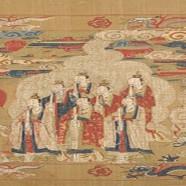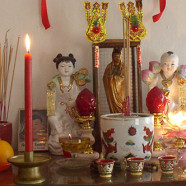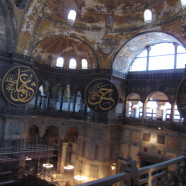Gold Mother of Shining Lake (瑤池金母) (part 1)
Encounter at the Mineral Spa “Gold Mother has yet another title. Wu Ji Li Tian (無極理天). She is the Divine Logos beyond all form. Roughly, her name can mean “The Realm of Infinite Possibility beyond all polarity.” A mild winter’s day in Beitou. I slide easily into the flowing waters of the Beitou mineral spa, and its silky warmth entices me into a dreamy, trance-like state. My head is still spinning from the encounter just now at the private temple of Yaochi Jinmu (瑤池金母), or the Golden Mother of the Shining Lake. Her other name is Xiwangmu, Queen Mother from the West. If you have read the famous Chinese Taoist novel, or seen an animated version of Monkey, you might have an idea of Xiwangmu. She is the Queen Mother of Paradise who throws a birthday party and invites all the gods and celestials to attend. On her birthday feast, she gives away peaches of immortality to her guests, a much coveted treat even among the gods! However Monkey stole into the orchard and ate up all the peaches! We were in Xin Beitou (New Beitou), the area around Xin Beitou MRT Station and Qinshui Park, north of Taipei city. Developed as a hot spring resort during the Japanese era (1895-1945), it enjoyed the notoriety of being a red-light district. But in the past 20 years, the government has upgraded the entire area so that the tree-lined, lush hill city of Xin Beitou, from MTR station all the way up to the mountain top, is now lined with high quality spas, deluxe hotels, and good restaurants. . Behind the mineral spa area lays Yangmingshan National Park famous for its seasonal splendors. Plum flowers in winter, azaleas and cherry blossoms every spring, picturesque hiking trails, and stately homes of government bureaucrats and famous men of letters. Mineral waters stream from numerous geothermal vents that populate the region and are famous for their health benefits. Since Japanese colonization, the hot springs have improved to include aroma therapy, massage, acupuncture, and excellent food which contribute towards the fulfilling spa experience. It was the 4th day after Chinese New Year in Hong Kong. The Year of the Dragon had just settled in, and I was nudged to travel to Beitou, after my last visit which was ten years ago. I said to my girlfriend, “Let’s go soak in the mineral springs and truly r-e-l-a-x!” The flight from Hong Kong to Taipei is just a little over an hour. Little did we know that we were in for a little adventure of our own. On this particular day, we had made reservations at a designer spa, situated right at the mouth of the largest geothermal vent of the Beitou Valley. Due to the smell of sulfur and the constant rising of steam, Beitou Valley has the appearance of a witch’s cauldron. Aboriginal inhabitants of the area named it paktaaw, meaning ‘witch’. We were entering the witch’s brew. Surprise Audition in a Taoist Shrine Spring Hotel is where we stayed was further up the hill. In the afternoon, my girlfriend and I strolled down the hill from our hotel towards the designer spa. It was a 20 minute walk. As we turned the corner and was just about to arrive at our destination, we stumbled upon a beautiful mansion by the roadside. The outdoor patio was drenched in the golden-ocher rays of the afternoon sun. Statues of Buddhist and Taoist gods–including Bodhidharma–carved out of marble and granite, were spread out all over the patio, and nestled amidst pine and cypress trees. I should note here that in Taiwan, Buddhism,...
Read MoreSoul Genetics: Why should you honor your ancestors?
Does this predicament sound familiar to you? You are plagued by a certain illness that won’t go away; you are always moody, depressed or fatigued; you are overwhelmed by a nasty situation either involving work, finances, or relationships… and no matter what you do and how hard you try, the problem won’t away. And when all conventional remedies fail to produce relief or improvement, you start to wonder: what on earth is the reason, and why?? Have you ever considered that the problem may have something to do with your departed ancestors? ULTIMATELY, WHO IS CONTROLLING YOUR SOUL? Here I want to bring up the term Soul Genetics, introduced by Dr. Pillai, an internationally famous Tamil scholar-mystic and philanthropist, founder of Astroved and Pillai Center. Soul Genetics refer to soul properties inherited from your ancestors. Just as you would inherit biological genes that build your body, you also inherit soul genes from your ancestral lines. You may inherit positive or negative traits from your forebears, which pave the way for either a happy, healthy and successful life, or a visit to hell! Most people experience a mixed bag. They inherit some positive soul traits, but also some tough karma thrown in through the generations. On top of our personal karma, there is also ancestral or tribal karma–the composite of karmic momentum accrued by your forefathers and mothers. Although people may not be aware of this, their physical ailments, mental distress, also the obstacles they encounter in their career, family and relationships, etc., are often directly related to bum ancestral karma. What is the remedy for this? The easiest way to shift your circumstance is by feeding your ancestors. SIMPLE HANDS-ON RITUAL Many cultures in the Far East & Southeast Asia have rituals honoring ancestors. India, Japan, China, Tibet, Thailand, Bali, to name a few. Today I am introducing a hands-on ritual that I find to be the most simple, practical, and effective. It stems from the Tamil Siddha tradition of South India and the gist of it consists of offering white rice flour mixed with black sesame seeds and water, and offering it to your ancestors. That’s all. It’s that simple. You can start right away. Just put white rice flour, black sesame seed, and darbha grass (optional) and mix it in a zip lock bag or glass bottle. I don’t even use darbha grass since we don’t have it in our area. I put the mixture in a little bottle, and every morning place a smidgeon on my right palm, and say a prayer to my ancestors. I call upon generations (at least six) from my father and mother’s side. I also say “Arut Perum Jyoti” over the mixture, invoking the Light to doubly bless the offering. The optimal hours are 6 a.m.-6 p.m. between sunrise and sunset, because that’s when ancestors are closest to the earth plane, and they can easily avail themselves of your offering. Make sure you say a prayer of thanks to ancestors of 6 generations of your father side, and 6 generations of your mother side. You can call in your ancestral lineages from even a broader gene pool. The secret is to intend your offering with great respect and appreciation. Put up any request you have, or, if you need their help and support in solving any specific issue, state it clearly. Then rinse your hand off. Some people store a small bottle of tarpanam mix by their shower rack, and do it first thing in the morning as they step into their shower. The entire process takes just a couple minutes. I...
Read MoreIstanbul, Where East meets West
This slideshow requires JavaScript. In late January of 2010 I embarked upon a journey to Turkey and Egypt that proved to be life-changing. This sacred journey triggered a quickening in my evolution. Our first destination was Istanbul. A small group of us – six women – started out from the Bay Area, California. We touched down in Istanbul smack into a blizzard with sub-zero temperatures, but even the cold and wet sleet could not dampen our excited spirits. A thriving megacity with a population of 12 million, Istanbul is prosperous, modern, ancient and exotic all at once. Located on the Bosporus Strait and hugging a natural harbor famously named the Golden Horn, Istanbul straddles both the European and Asian side of the Bosporus, making it the only metropolis that sits on two continents. Historically called Byzantium and Constantinople, Istanbul was capital of the Eastern Roman Empire (395–1204 and 1261–1453), also the Ottoman Empire (1453–1922). The stones, pavements, tiles, rubble–even the very air of this ancient city ooze history and culture. The world famous Topkapi Palace attests to the opulence and stylish splendor of the Ottoman Empire. Spellbound, we wandered through the palace grounds thickly covered in snow. Topkapi was built by the first ruler of the Ottoman Empire, Sultan Mehmed II, and served as the primary residence of the Ottoman Sultans for 400 years of their 600-year reign. Consisting of four huge courtyards and adjoining buildings, the sprawling palace complex boasted over 4,000 occupants in its heyday. The incessant, thick snowfall evoked a magnetic ambience! We drank in the rich plethora of Ottoman miniatures, Islamic calligraphic manuscripts, blue and white Chinese celadon, murals, fabulous treasures and jewelry. Intricately embossed inscriptions of ultramarine blue and gold leaf and tiles of jewel-colored geometric designs adorned the Harem. We marveled at the 86 carats pear-shaped Spoonmaker’s diamond. And gaped at brilliant emeralds, tourmalines, rubies and south sea pearls that are bigger than large grapes. I especially marveled at the sanctity of the Hagia Sophia. Topped by a massive dome, this stone basilica is considered the quintessence of Byzantine construction and is said to have “changed the history of architecture.” Giant wall paintings of the Seraphim vibrated with an intense electric presence and started to glow, and for a moment I felt swept into Eternity’s embrace of golden Light. I could have stayed in that space for days. The Blue Mosque perched on a hill overlooking the Marmara Sea, is a living example of symmetry, elegance, and geometric ingenuity of Mosque architecture. In a park next to the Blue Mosque, we visited the remnants of the once-humongous Hippodrome. Originally used for chariot racing and other public events, the stadium used to hold over 100,000 people. It was the center of life in Byzantine Constantinople for over 1,000 years and of Ottoman life in Istanbul for over 400 years. But now only very little is left of this once-glorious splendor. The most notable remaining column is the Egyptian Obelisk, which was built in Egypt in 1500 BC and once stood in Luxor before Emperor Constantine brought it to his city. We enjoyed our tour of the Grand Bazaar, where my friends bargained with tireless shop keepers and bought evil-eye amulets, lamps, and candle holders. We couldn’t resist sampling the scores of tempting Turkish Delight candies in the Spice Market. And since a trip to Turkey wouldn’t be complete without a Turkish bath, we had the complete treatment at a localhamams. Turkish food agreed with us—we relished the wide variety of local foods, including the wickedly sumptuous desserts and Turkish coffee. I even learned to read coffee...
Read More








Recent Comments